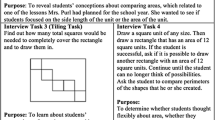Abstract
The objective of this study was to characterise prospective kindergarten teachers’ development of noticing children’s thinking about length and its measurement. We used the concepts of instrumental genesis and learning trajectories to identify the ways in which prospective kindergarten teachers used a learning trajectory to learn to notice children’s mathematical thinking. Following a teaching experiment, we identified three ways in which prospective kindergarten teachers used the learning trajectory to notice children’s mathematical thinking. Two instrumented action schemes supported these ways of using the learning trajectory, namely, a scheme taking into account the mathematics learning progression to interpret children’s answers, and a scheme for proposing instructional tasks based on the interpretation of children’s mathematical thinking. Approaching the development of noticing as an appropriation process of a learning trajectory helps us to understand prospective teachers’ difficulties in endowing meaning to a learning trajectory’s conceptual structure. We suggest that these ways of using learning trajectory knowledge to interpret children’s mathematical thinking and to make instructional decisions can be understood as an instrumentation process that reveals how noticing skills develop.



Similar content being viewed by others
References
Alsina, A. (2011). Educación matemática en contexto: de 3 a 6 años. I.C.E. Universitat de Barcelona
Amador, J. (2020). Noticing as a tool to analyze mathematics instruction and learning. In International handbook of mathematics teacher education. Volume 2: Tools and processes in mathematics teacher education, (pp. 310–336). Place: Leiden.
Clements, D. H., & Sarama, J. (2004). Learning trajectories in mathematics education. Mathematical Thinking and Learning, 6(2), 81–89.
Fernández, C., & Choy, B.H. (2020). Theoretical lenses to develop mathematics teacher noticing. In International handbook of mathematics teacher education. Volume 2: Tools and processes in mathematics teacher education, (pp. 337–360). Place: Leiden.
Gasteiger, H., & Benz, C. (2018). Enhancing and analyzing kindergarten teachers’ professional knowledge for early mathematics education. Journal of Mathematical Behavior, 51, 109–117. https://doi.org/10.1016/j.jmathb.2018.01.002.
Gasteiger, H., Bruns, J., Benz, C., Brunner, E., & Sprenger, P. (2020). Mathematical pedagogical content knowledge of early childhood teachers: A standardized situation-related measurement approach. ZDM Mathematics Education, 52, 193–205. https://doi.org/10.1007/s11858-019-01103-2.
Ivars, P., Fernández, C., & Llinares, S. (2020). A learning trajectory as a scaffold for pre-service teachers’ noticing of students’ mathematical understanding. International Journal of Science and Mathematics Education, 18(3), 529–548.
Ivars, P., Fernández, C., Llinares, S., & Choy, B. H. (2018). Enhancing noticing: Using a hypothetical trajectory to improve pre-service primary teachers’ professional discourse. EURASIA Journal of Mathematics, Science and Technology Education, 14(11), em1599.
Jacobs, V. R., Lamb, L. C., & Philipp, R. A. (2010). Professional noticing of children’s mathematical thinking. Journal for Research in Mathematics Education, 41(2), 169–202.
Lee, J. E. (2017). Preschool teachers’ pedagogical content knowledge in mathematics. International Journal of Early Childhood, 49(2), 229–243. https://doi.org/10.1007/s13158-017-0189-1.
Llinares, S. (2019). Indicators for the development of noticing: How do we recognize them? For the Learning of Mathematics, Monograph, 1, 38–43.
Lobato, J., & Walters, C. D. (2017). A taxonomy of approaches to learning trajectories and progressions. In J. Cai (Ed.), Compendium for research in mathematics education (pp. 74–101). Reston, VA: National Council of Teachers of Mathematics.
Mason, J. (2002). Researching your own practice. The discipline of noticing. Mahwah: Routledge.
Parks, A. M., & Wager, A. A. (2015). What knowledge is shaping teacher preparation in early childhood mathematics? Journal of Early Childhood Teacher Education, 36(2), 124–141. https://doi.org/10.1080/10901027.2015.1030520.
Rabardel, P. (2002). People and technology—A cognitive approach to contemporary instruments. https://hal.archives-ouvertes.fr/hal-01020705.
Santagata, R., Zannoni, C., & Stigler, J. W. (2007). The role of lesson analysis in pre-service teacher education: An empirical investigation of teacher learning from a virtual video-based field experience. Journal of Mathematics Teacher Education, 10(2), 123–140.
Sarama, J., & Clements, D. (2009). Early childhood mathematics education research: Learning trajectories for young children. London: Routledge.
Scheiner, T. (2016). Teacher noticing: Enlightening or blinding? ZDM Mathematics Education, 48(1–2), 227–238. https://doi.org/10.1007/s11858-016-0771-2.
Scheiner, T. (2020). Towards a more comprehensive model of teacher noticing. ZDM Mathematics Education. https://doi.org/10.1007/s11858-020-01202-5.
Sherin, M., Jacobs, V., & Philipp, R. (Eds.). (2011). Mathematics teacher noticing: Seeing through teachers’ eyes. London: Routledge.
Sherin, M. G., & van Es, E. A. (2009). Effects of video club participation on teachers’ professional vision. Journal of Teacher Education, 60(1), 20–37.
Trouche, L. (2020a). Instrumentalization in mathematics education. In S. Lerman (Ed.), Encyclopedia of mathematics education (pp. 392–403). Cham: Springer.
Trouche, L. (2020b). Instrumentation in mathematics education. In S. Lerman (Ed.), Encyclopedia of mathematics education (pp. 404–412). Cham: Springer.
Van den Heuvel-Panhuizen, M., & Buys, K. (2005). Young children learn measurement and geometry. TAL Project. Freudenthal Institute, Utrech University and National Institute for Curriculum Development
Verillon, P., & Rabardel, P. (1995). Cognition and artifacts: A contribution to the study of thought in relation to instrument activity. European Journal of Psychology of Education, 9(3), 77–101.
Wilson, P. H., Mojica, G., & Confrey, J. (2013). Learning trajectories in teacher education: Supporting teachers’ understanding of students’ mathematical thinking. The Journal of Mathematical Behavior, 32(2), 103–121.
Wilson, P. H., Sztajn, P., Edgington, C., Webb, J., & Myers, M. (2017). Changes in teachers’ discourse about students in a professional development on learning trajectories. American Educational Research Journal, 54(3), 568–604.
Acknowledgements
This research was funded by the national Spanish Project: EDU2017-87411-R-‘Ministerio de Economía and Competitividad, Gobierno de España’.
One of the authors of this paper, Maria Luz Callejo, passed away when we were reviewing it to ZDM. We would like to remember her with this paper.
Author information
Authors and Affiliations
Corresponding author
Additional information
Publisher's Note
Springer Nature remains neutral with regard to jurisdictional claims in published maps and institutional affiliations.
María Luz Callejo: Deceased.
Rights and permissions
About this article
Cite this article
Moreno, M., Sánchez-Matamoros, G., Callejo, M.L. et al. How prospective kindergarten teachers develop their noticing skills: the instrumentation of a learning trajectory. ZDM Mathematics Education 53, 57–72 (2021). https://doi.org/10.1007/s11858-021-01234-5
Accepted:
Published:
Issue Date:
DOI: https://doi.org/10.1007/s11858-021-01234-5




